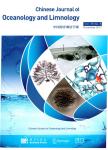THE BAROCLINIC RESIDUAL CIRCULATION IN SHALLOW SEAS I. THE HYDRODYNAMIC MODELS
THE BAROCLINIC RESIDUAL CIRCULATION IN SHALLOW SEAS I. THE HYDRODYNAMIC MODELS作者机构:Shandong College of Oceanology Qingdao China
出 版 物:《Chinese Journal of Oceanology and Limnology》 (中国海洋湖沼学报(英文版))
年 卷 期:1984年第2卷第1期
页 面:49-60页
主 题:THE HYDRODYNAMIC MODELS THE BAROCLINIC RESIDUAL CIRCULATION IN SHALLOW SEAS I Bay
摘 要:There are two different modeling approaches which have been proposed and utilized to derive residual currents: the first approach is equivalent to deducing residual currents from current-meter records using filtering techniques or time averages of time-series records to remove tidal variations; in the second approach, filters or time averages over several tidal cycles are applied to the hydrodynamic equations to generate the governing equations for residual circulation. Based on the latter, both the baroclinic dynamic models of residual circulation are proposed, of which one is a two-dimensional transport model and the other is a three-dimensional model with variable eddy viscosity. The two-dimensional transport model is a direct generalization from the barotropic model of residual circulation presented by Nihoul and Randy (1975) and Heaps (1978) to the baroclinic model. In the three-dimensional model with variable eddy viscosity, using a Sturm-Liouville system adopted in the reference [5], the nondimen



